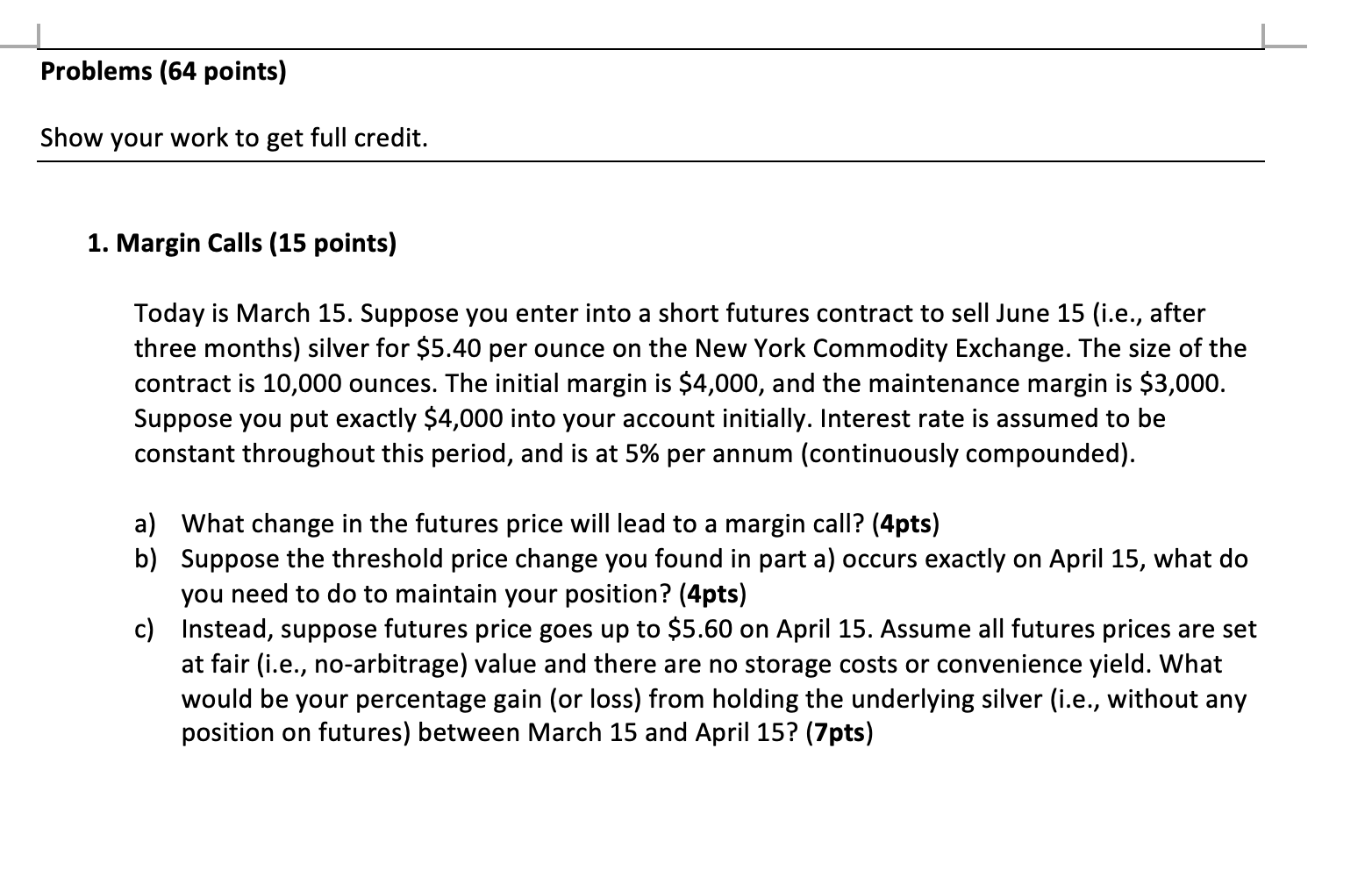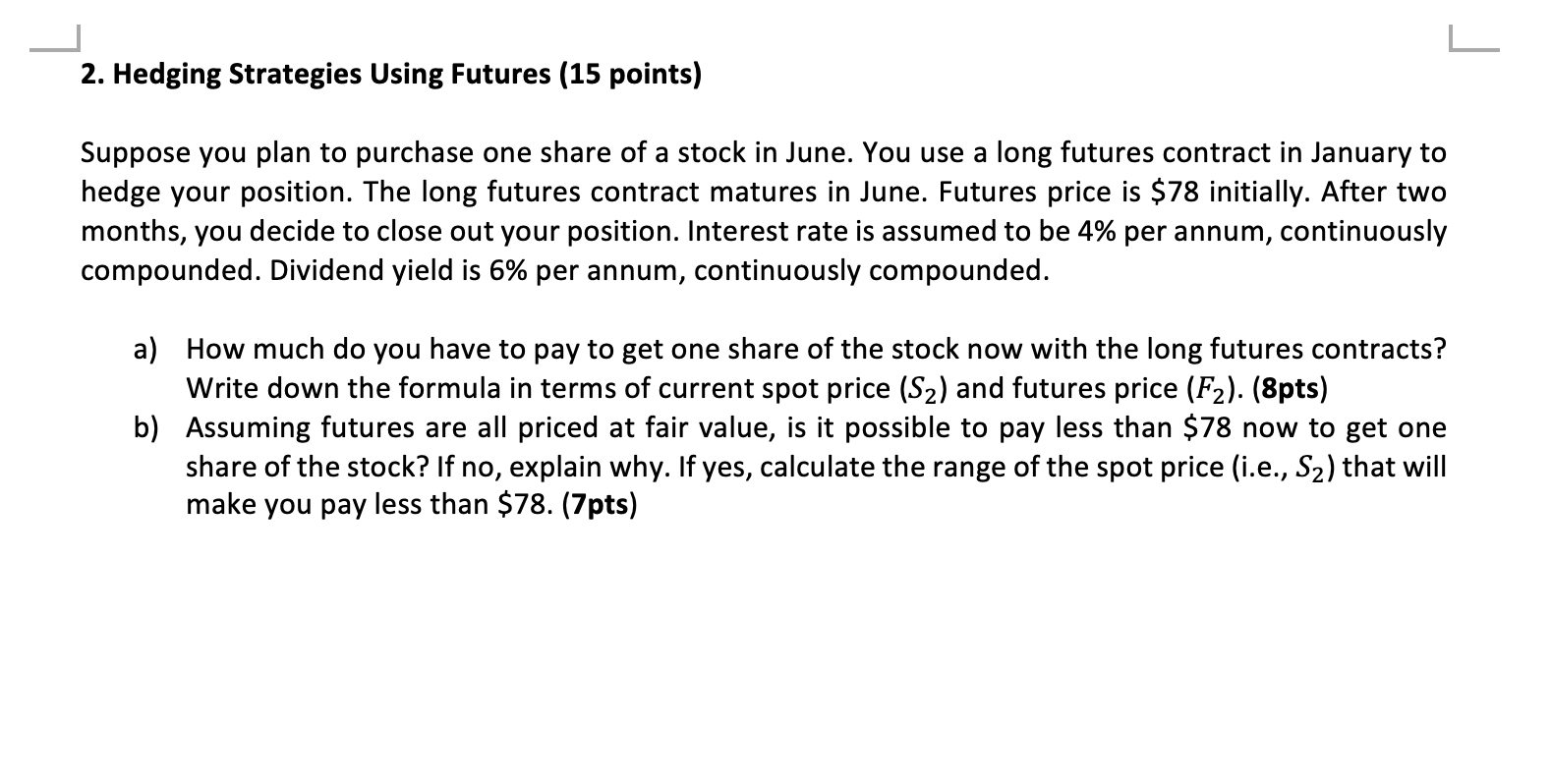

Problems (64 points) Show your work to get full credit. 1. Margin Calls (15 points) Today is March 15. Suppose you enter into a short futures contract to sell June 15 (i.e., after three months) silver for $5.40 per ounce on the New York Commodity Exchange. The size of the contract is 10,000 ounces. The initial margin is $4,000, and the maintenance margin is $3,000. Suppose you put exactly $4,000 into your account initially. Interest rate is assumed to be constant throughout this period, and is at 5% per annum (continuously compounded). a) What change in the futures price will lead to a margin call? (4pts) b) Suppose the threshold price change you found in part a) occurs exactly on April 15, what do you need to do to maintain your position? (4pts) c) Instead, suppose futures price goes up to $5.60 on April 15. Assume all futures prices are set at fair (i.e., no-arbitrage) value and there are no storage costs or convenience yield. What would be your percentage gain (or loss) from holding the underlying silver (i.e., without any position on futures) between March 15 and April 15? (7pts) 2. Hedging Strategies Using Futures (15 points) Suppose you plan to purchase one share of a stock in June. You use a long futures contract in January to hedge your position. The long futures contract matures in June. Futures price is $78 initially. After two months, you decide to close out your position. Interest rate is assumed to be 4% per annum, continuously compounded. Dividend yield is 6% per annum, continuously compounded. a) How much do you have to pay to get one share of the stock now with the long futures contracts? Write down the formula in terms of current spot price (S2) and futures price (F2). (8pts) b) Assuming futures are all priced at fair value, is it possible to pay less than $78 now to get one share of the stock? If no, explain why. If yes, calculate the range of the spot price (i.e., S2) that will make you pay less than $78. (7pts) Problems (64 points) Show your work to get full credit. 1. Margin Calls (15 points) Today is March 15. Suppose you enter into a short futures contract to sell June 15 (i.e., after three months) silver for $5.40 per ounce on the New York Commodity Exchange. The size of the contract is 10,000 ounces. The initial margin is $4,000, and the maintenance margin is $3,000. Suppose you put exactly $4,000 into your account initially. Interest rate is assumed to be constant throughout this period, and is at 5% per annum (continuously compounded). a) What change in the futures price will lead to a margin call? (4pts) b) Suppose the threshold price change you found in part a) occurs exactly on April 15, what do you need to do to maintain your position? (4pts) c) Instead, suppose futures price goes up to $5.60 on April 15. Assume all futures prices are set at fair (i.e., no-arbitrage) value and there are no storage costs or convenience yield. What would be your percentage gain (or loss) from holding the underlying silver (i.e., without any position on futures) between March 15 and April 15? (7pts) 2. Hedging Strategies Using Futures (15 points) Suppose you plan to purchase one share of a stock in June. You use a long futures contract in January to hedge your position. The long futures contract matures in June. Futures price is $78 initially. After two months, you decide to close out your position. Interest rate is assumed to be 4% per annum, continuously compounded. Dividend yield is 6% per annum, continuously compounded. a) How much do you have to pay to get one share of the stock now with the long futures contracts? Write down the formula in terms of current spot price (S2) and futures price (F2). (8pts) b) Assuming futures are all priced at fair value, is it possible to pay less than $78 now to get one share of the stock? If no, explain why. If yes, calculate the range of the spot price (i.e., S2) that will make you pay less than $78. (7pts)








